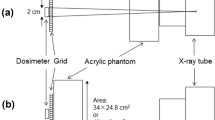Abstract
Our purpose in this study was to establish a selection standard for anti-scatter grids for a direct conversion flat-panel detector (FPD) system. As indices for grid evaluation, we calculated the selectivity, Bucky factor, and the signal-to-noise ratio improvement factor (SIF) by measuring rates of scatter transmission, primary transmission, and total transmission (based on the digitally displayed measurement values of the FPD system), using 4 acrylic phantoms of different thicknesses. The results showed that the SIF was less than 1.0 when the phantom thickness was 5 cm. When the phantom thickness was 25 cm and the grid ratio was 16:1, the SIF was 1.505 and 1.518 (maximum value) at 90 and 120 kV, respectively. Compared with the grid ratio of 12:1, the SIF at the grid ratio 16:1 was improved by 6.1% at 90 kV, and by 7.0% at 120 kV. In a direct-conversion FPD system, the grid ratio of 16:1 is considered adequate for eliminating the scattered-radiation effect when much scattered radiation is present, such as with a thick imaged object or a high X-ray tube voltage.



Similar content being viewed by others
References
Niklason LT, Sorenson JA, Nelson JA. Scattered radiation in chest radiography. Med Phys. 1981;8:677–81.
Fetterly KA, Schueler BA. Physical evaluation of prototype high-performance anti-scatter grids: potential for improved digital radiographic image quality. Phys Med Biol. 2009;54:37–42.
Sandborg M, Dance DR, Carlsson GA, Persliden J. Monte Carlo study of grid performance in diagnostic radiology: task dependent optimization for screen-film imaging. Br J Radiol. 1994;67:76–85.
Sandborg M, Dance DR, Carlsson GA, Persliden J. Monte Carlo study of grid performance in diagnostic radiology: factors which affect the selection of tube potential and grid ratio. Br J Radiol. 1993;66:1164–76.
Sandborg M, Dance DR, Carlsson GA, Persliden J. Selection of anti-scatter grids for different imaging tasks: the advantage of low atomic number cover and interspace materials. Br J Radiol. 1993;66:1151–63.
McVey G, Sandborg M, Dance DR, AlmCarlsson G. A study and optimization of lumbar spine X-ray imaging systems. Br J Radiol. 2003;76:177–88.
Chan HP, Doi K. The validity of Monte Carlo simulation in studies of scattered radiation in diagnostic radiology. Phys Med Biol. 1983;28:109–29.
Chan HP, Higashida Y, Doi K. Performance of antiscatter grids in diagnostic radiology: experimental measurements and Monte Carlo simulation studies. Med Phys. 1985;12:449–54.
Ishikawa M, Ide T, Asano H, Sagawa Z, Miyake H, Kamishima Y, Negishi T. Physical characteristics of anti-scatter grids according to old and new JIS standards (in Japanese). Nippon Hoshasen Gijutsu Gakkai Zasshi. 2004;60:1123–31.
Sandborg M, Carlsson GA. Influence of X-ray energy spectrum, contrasting detail and detector on the signal-to-noise ratio (SNR) and detective quantum efficiency (DQE) in projection radiography. Phys Med Biol. 1992;37:1245–63.
Court L, Yamazaki T. Technical note: a comparison of antiscatter grids for digital radiography. Br J Radiol. 2004;77:950–2.
Fetterly KA, Schueler BA. Experimental evaluation of fiber-interspaced antiscatter grids for large patient imaging with digital X-ray systems. Phys Med Biol. 2007;52:4863–80.
Neitzel U, Maack I, Günther-Kohfahl S. Image quality of a digital chest radiography system based on a selenium detector. Med Phys. 1994;21:509–16.
Chan HP, Lam KL, Wu YZ. Studies of performance of antiscatter grids in digital radiography: effect on signal-to-noise ratio. Med Phys. 1990;17:655–64.
IEC61267. Medical diagnostic X-ray equipment—radiation conditions for use in the determination of characteristics. 1994.
Author information
Authors and Affiliations
Corresponding author
About this article
Cite this article
Mizuta, M., Sanada, S., Akazawa, H. et al. Comparison of anti-scatter grids for digital imaging with use of a direct-conversion flat-panel detector. Radiol Phys Technol 5, 46–52 (2012). https://doi.org/10.1007/s12194-011-0134-1
Received:
Revised:
Accepted:
Published:
Issue Date:
DOI: https://doi.org/10.1007/s12194-011-0134-1



